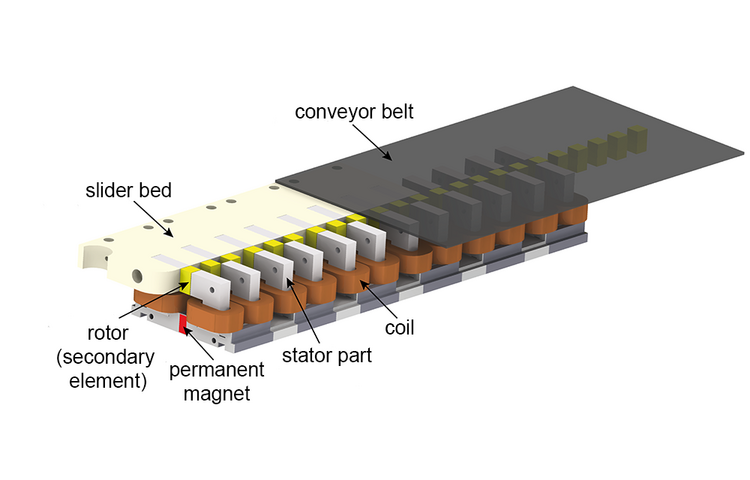LinTrans-Transfer

| E-Mail: | malte.kanus@ita.uni-hannover.de |
| Year: | 2017 |
| Date: | 01-12-19 |
| Funding: | DFG |
| Duration: | 04/2017 – 12/2018 |
Figure 1 : Design of the hybrid motor [Rad2016].
In the field of warehousing belt conveyor systems are used to transport single piece goods and light bulk material. When using conventional drive systems, the feed force has to be transmitted by frictional force over the driven pulley to the conveyor belt. Changing customer requirements, such as higher mass flows or longer conveying distances, lead to the necessity of splitting to multiple conveyors with shorter sections or belts with a higher nominal strength. For the reduction of the conveyor belt stress, alternative drive principles are focus of current research (see figure 2). The first concept consists of driven idlers whereas the driven pulley is relieved and therefore the belt stress is reduced at the same time. Linear direct drives constitute another alternative drive system. In contrast to conventional drive systems, here, the feed force results from the electro-magnetic field and is transmitted over the motor length directly into the conveyor belt without further mechanical transmission elements.

Figure 2: Alternative drive concepts for belt conveyors [Rad2016].
Figure 2 shows the structure known from previous projects. One of the advantages of a linear motor is the direct contactless introduction of forces into the belt. In addition to the lower pre-tensioning force, which is required for the build-up of the friction forces in conventional belt conveyors, the force level can be significantly reduced by the distributed force introduction along the linear motor. This results in new possibilities in the design of conveyor belts. On the one hand, no high-strength and thus expensive conveyor belts are required, and on the other hand, the conveyor can be extended by using multiple linear motors.
In the context of a DFG-funded project in cooperation with the Institute for Drive Systems and Power Electronics (IAL) and Wittenstein cyber motor GmbH, the drive is realized using a linear motor. Basis for this are the results of previous research projects. Goal for the ITA in cooperation with the partners Forbo Siegling GmbH and TRANSNORM System GmbH, is the design and the development of the secondary elements in combination with the conveyor belt. For evaluation purposes a common demonstrator will be built which is part of a conveying scenario. The comparison to conventional conveyors will show the advantages of linear direct drives and corresponding requirements for the development to series-production readiness.
[Rad2016]: Linear direct drive for belt conveyors in production technology Hanover information (phi)




















